Really awesome it is to interview people who have been a part of the cinematic high water marks of one’s life. But this one was special. Several weeks back my beloved wife, Jennifer, was looking at pictures online from the MoPOP (The Museum of Popular Culture): Jim Henson exhibit. She, as am I, is a fan of the worlds created by Henson and particularly thrilled at seeing Sarah’s ball gown from Labyrinth. She said I needed to track down the costume designer and interview her. So I did. Easier said than done right? Well yeah. I admit, I have had ridiculous luck since joining the crew at podcastingthemsofly.com when it has come to tracking down industry professionals for a chat. During the construction of my anthology trilogy Straight to Video, I had prided myself on getting a hold of filmmakers, some of whom I knew, but many I didn’t. Following that, and in starting my on modest publishing business, I tried to keep the magic going – hoping to secure forewords from filmmakers who were willing to read friend’s books and write introductions for them.
I was so happy to do it this time for my wife, who, while she has tastes that differ from mine, we certainly share a bunch of common cinematic favorites of which Labyrinth is one.
So I am proud to present this brief insight into the life of Ellis Flyte, costume designer on Labyrinth and also part of the creative team that brought us that other Henson spectacular, The Dark Crystal. From humble beginnings, she worked in theater and television but also enjoyed success as a fashion designer in demand. Then there came her work with the Henson Company; on two of its crowning glories. She was also, for a time, married to Henson’s son Brian.
Ellis was very generous to lend some of her time to answer a handful of questions on her contribution to a remarkable film.
So through dangers untold, and hardships unnumbered, I have fought my way here to the castle beyond the Goblin City to present to you, ladies and gentlemen . . . Ellis Flyte.
KH: Could you tell us a little of your origins?
EF: In brief, I am Scottish and as a youth spent a lot of time making clothes out of rugs and similar strange fabrics to everyone’s amusement, but primarily wanted to be a ballet dancer. Following a very severe accident I completed my exams at school and left to London to study fashion instead.
KH: What were your creative aspirations? Was working in the fashion industry or film always your dream?
EF: My first employment during college evenings was in theatre in the costume department which I thoroughly enjoyed. Both fashion and costume would be the two key passions for most of my life, and I worked in many great theatres, contemporary dance studios and television. However I was to become more celebrated in those years as a fashion designer, working from my living room in South London, and selling through Liberty and Browns and Harvey Nichols. Later on in my career I would also design and dress actors, singers and celebrity as well as my collections. Both are really all-consuming creative lifestyles with very little time off but you love it so I have no problems with this!
KH: How did you come to work for the Henson Company? It must have been so incredible to work with Jim Henson; he seems to have been such a vital spark, a creative genius?
EF: I had taken a television job which was coming to an end and I saw an advert to work in film, so I went along for an interview. You can imagine how astonished I was to be asked if I had ever worked on puppets. My first job was as an assistant to Polly Smith, working on the extraordinary “Dark Crystal”. This was of course a Jim Henson film and also the concept of Brian Froud, where I and a large team of the best artists and technicians worked together in various departments creating the special effects vital to the end result. Long hours but so much fun. We shot the film at Elstree.
Following the release of Dark Crystal six of us were asked to design the “Dark Crystal fashion collection” of gowns based on the movie characters which turned into another totally new and exciting project! So as you can see I had already met the genius Jim Henson and loved working in their company!
KH: Tell us about your experience on the production of Labyrinth? Sarah’s masquerade dress in Labyrinth, indeed all the costumes you did, were based on concepts created by you along with Brian Froud?
EF: Labyrinth was considerably later and a joy to be chosen for the position! Yes it is a Jim Henson film and once again the Conceptual Designer was Brian Froud.
He brought to me many sketches of costumes from which my job would be to create and realise the ideas and also introduce new detail or interpretation. My first responsibility would be to David Bowie and to Jennifer Connelly, and then to the surreal costume ball. It has to be said that I employed a large team of people from pattern cutters and sewing technicians, screen print and dye specialists, special effect creators, jewellery designers and make-up and hair stylists, amongst others, and it is due to their continued hard work, originality and independent skills that we came to the finished product!
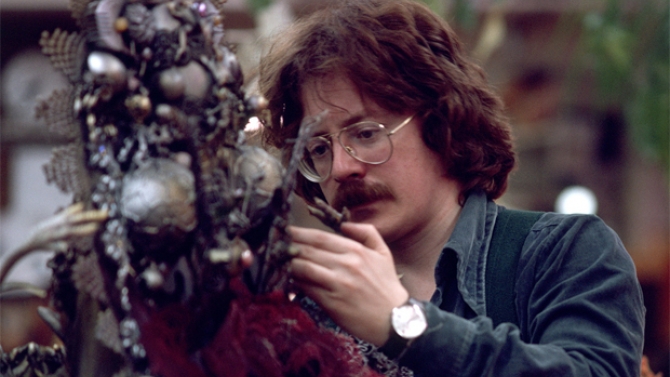
KH: Did the final costumes mirror the concept drawings or we’re the altered as filming commenced, and material did you use? The dress now seems yellowed in photos from the MoPOP exhibit, is that purely due to age or was that the way it was lit during filming to lend it the ethereal quality of the sequence?
EF: Sarah’s ball gown took a lot of sampling and camera tests to achieve! We wanted her to look like an otherworldly princess and very different to the others at the ball. The ethereal effect was achieved by many secret devices including layers of lace, lame and rainbow paper, spray paint and broken jewels, and then the entire ballroom garments were distressed to look as if they had been dancing forever! Hemlines were broken down and dust was sprayed into the creases – the masks also present a sinister look to the event don’t they? The fabric choice for the ladies was chosen to give depth and colour and also for movement as you say, although of course all dresses were crinoline underneath.
KH: What was your favourite costume to design and which costumes were the most challenging to not only create but to realize in a finished garment?
EF: The ballroom sequence was a terrific challenge but I really enjoyed all of it, my two favourite costumes in that sequence were probably those for Jennifer and David’s jewelled velvet tail coat. The trickiest pieces were most of David’s as they were designed to be highly original and didn’t always transfer from sketch to actual garment! A leather jacket with a special effect finish was particularly tricky but we got there in the end! Plus we had a load of laughs with the stretch trousers over various cod-pieces. We also tried many different hair styles and make-up effects before Jim and Brian made their final selection! To realise the characters and then have the creative freedom to add or expand my ideas is a costume designers dream and when it works it is really wonderful! It was a huge task to put it all together plus detail of jewellery, accessories and hair pieces but I loved the way it was shot.
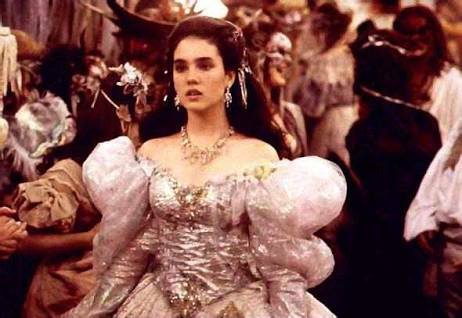
KH: Labyrinth is a treasured film of my youth. Looking back at the film and the experience, how do you see the work and the film today?
EF: I think Labyrinth was ahead of its time as was Dark Crystal.
KH: What aspects of costume design do you enjoy the most and do you feel that costume design is an underrated element in films, attaining the recognition it deserves?
EF: To design costume there are so many dynamics – you have to enjoy the ability to multi-task!
You must understand the person you are dressing and their bodies, their favourite parts and their insecurities so that you can give your personal touch and increase their confidence and happiness and never disturb their performance. Also it is important to know how and where to shop for everything from highly individual/ period costume /unusual accessories/ to ordinary base cloth! And then to know how to work many different effects from any base or other fabrics and add the knowledge of what works on-screen in terms of colours, textures and finishes. I enjoy all of this, regardless of the project, and I have been lucky enough to have worked on many very different projects! Each one is challenging in a different way and a lot of research is required before you start. I do think costume is valued especially when it is well done! It is as important as the script or storyline and should help to identify a character, whatever the circumstances. It is now beginning to receive the acclaim it deserves.
KH: Have you ever been approached or would you consider putting out a book of your work?
EF: The book – that seems to be a constant question. I have had several magazine features but not yet a book on my fashion and film work.
There you have it. I was just as surprised to get in touch with Ellis as I was to have her participate in this interview, so, I send a big thank you.
I would like to add that the questions for Ellis were prepared by my wife and I was thrilled at her response to the answers. This one’s for you baby and I am here always…
…should you need us.
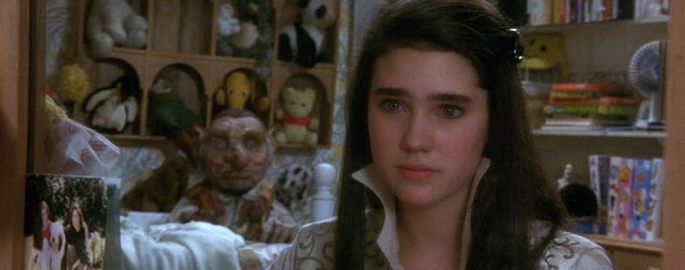










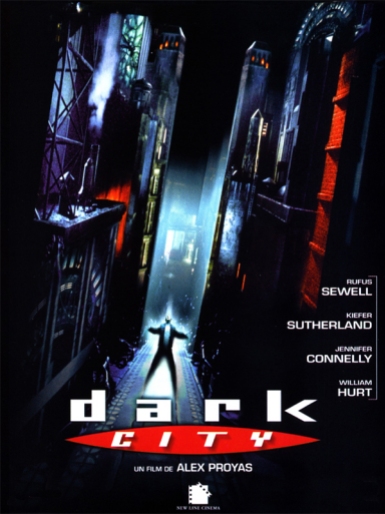









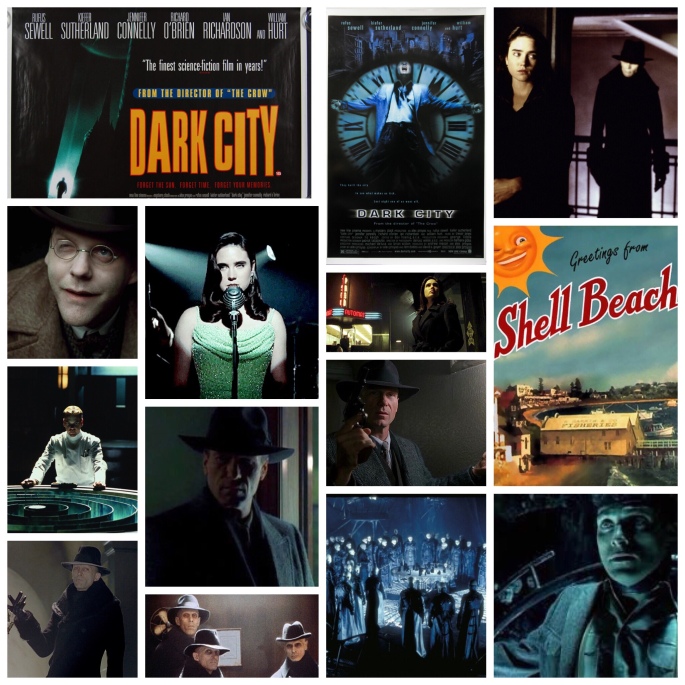




























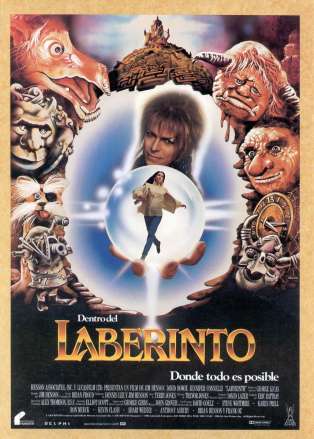








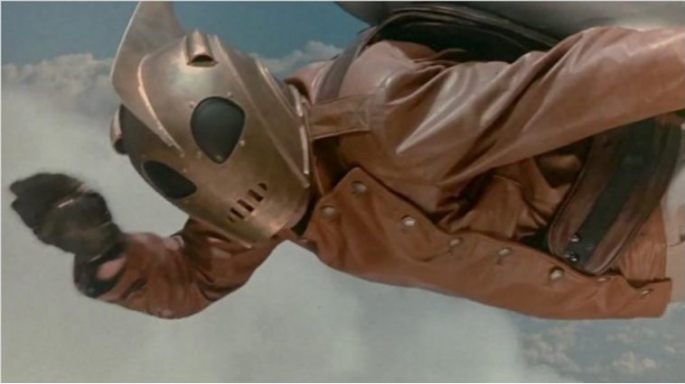
 Filmmaker Steve Miner (Friday the 13th, Parts II and III) was the first person to option the film rights to Dave Stevens’ independent comic book The Rocketeer but he ended up straying too far from the original concept and his version died an early death. Screenwriters Danny Bilson and Paul DeMeo (Trancers and Zone Troopers) were given the option in 1985. Stevens liked them because “their ideas for The Rocketeer were heartfelt and affectionate tributes to the 1930’s with all the right dialogue and atmosphere. Most people would approach my characters contemporarily, but Danny and Paul saw them as pre-war mugs.” Their subsequent screenplay kept the comic book’s basic plot intact but fleshed it out to include the Hollywood setting and the climactic battle against a Nazi zeppelin. They also tweaked Cliff’s girlfriend to avoid comparisons (and legal hassles) to Bettie Page (Stevens’ original inspiration), changing her from a nude pin-up model to a Hollywood extra while also changing her name from Betty to Jenny.
Filmmaker Steve Miner (Friday the 13th, Parts II and III) was the first person to option the film rights to Dave Stevens’ independent comic book The Rocketeer but he ended up straying too far from the original concept and his version died an early death. Screenwriters Danny Bilson and Paul DeMeo (Trancers and Zone Troopers) were given the option in 1985. Stevens liked them because “their ideas for The Rocketeer were heartfelt and affectionate tributes to the 1930’s with all the right dialogue and atmosphere. Most people would approach my characters contemporarily, but Danny and Paul saw them as pre-war mugs.” Their subsequent screenplay kept the comic book’s basic plot intact but fleshed it out to include the Hollywood setting and the climactic battle against a Nazi zeppelin. They also tweaked Cliff’s girlfriend to avoid comparisons (and legal hassles) to Bettie Page (Stevens’ original inspiration), changing her from a nude pin-up model to a Hollywood extra while also changing her name from Betty to Jenny. Like The Right Stuff (1983) before it, The Rocketeer is a love letter to the wonders of aviation and the brave souls that risked their lives pushing the envelope. In a nice touch, Cliff even chews Beeman’s gum, the same kind that Chuck Yeager uses in The Right Stuff. The comic book is masterfully translated to the big screen, right down to recreating the iconic Bull Dog Diner. The filmmakers also got all the details of Cliff and his alter ego right, including the casting of Billy Campbell. The same goes for Jenny, although, because Disney backed the film, they downplayed the blatant homage her character was to famous pin-up model Bettie Page. With Dave Stevens untimely passing in 2008, watching this film is now a bittersweet experience but there is some comfort in that at least he got to see his prized creation brought vividly to life even if failed to catch on with the mainstream movie-going public. The Rocketeer is flat-out wholesome fun with nothing more on its mind than to tell an entertaining story and take us on an exciting adventure.
Like The Right Stuff (1983) before it, The Rocketeer is a love letter to the wonders of aviation and the brave souls that risked their lives pushing the envelope. In a nice touch, Cliff even chews Beeman’s gum, the same kind that Chuck Yeager uses in The Right Stuff. The comic book is masterfully translated to the big screen, right down to recreating the iconic Bull Dog Diner. The filmmakers also got all the details of Cliff and his alter ego right, including the casting of Billy Campbell. The same goes for Jenny, although, because Disney backed the film, they downplayed the blatant homage her character was to famous pin-up model Bettie Page. With Dave Stevens untimely passing in 2008, watching this film is now a bittersweet experience but there is some comfort in that at least he got to see his prized creation brought vividly to life even if failed to catch on with the mainstream movie-going public. The Rocketeer is flat-out wholesome fun with nothing more on its mind than to tell an entertaining story and take us on an exciting adventure.